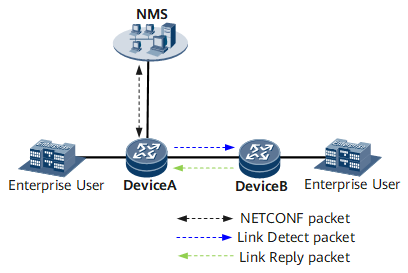Configuring LAD
Link Automatic Discovery (LAD) allows a device to issue link discovery requests and generates neighbor information based on the received link discovery replies. The device then saves local and neighbor information in the local MIB. The NMS can query neighbor information in the MIB and generate the topology of the entire network, helping network administrators locate inappropriate configurations.
Usage Scenario
LAD discovers physical and logical links when devices are connected directly or over a Layer 2 network. The information provided by LAD helps network administrators promptly obtain detailed network topology and changes in the topology and monitor the network status in real time, ensuring security and stability for network communication. On the network shown in Figure 1, before the NMS collects the topology of Device A and Device B, enable LAD on Device A and Device B so that Device A can send LAD packets to Device B and Device B can respond with LAD packets. After Device A receives LAD packets, it generates neighbor information and saves it in the local MIB, helping the NMS obtain the network topology.
Pre-configuration Tasks
Before configuring LAD, configure reachable routes between devices and the NMS and configure NETCONF parameters.
Verifying the Configuration
After configuring LAD, check the configurations.
Run the display link neighbor { slot slot-id | interface interface-type interface-number | all } command to check neighbor information of interfaces.
Run the display link neighbor all command to view neighbor information of all interfaces.
